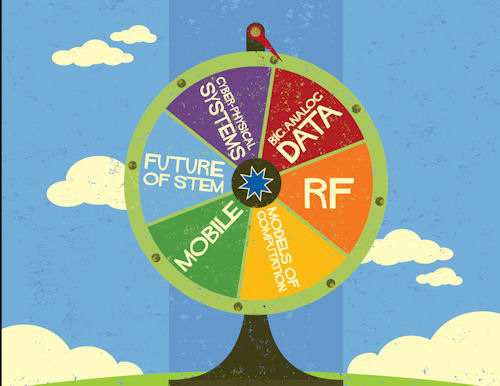NI Trend Watch 2014: Technology Trends That Accelerate Your Productivity
Latest News
February 27, 2014
 Dear Desktop Engineering Reader:
Dear Desktop Engineering Reader:
The earliest known English citation of the proverb “time and tide wait for no man” seems to date back to 1225. In 2014, we might update that to “time and technology wait for no man.” The natural progression of time and technology threatens to—and some day will—leave you behind. Knowing this often means we react to stimuli without a plan. We simply charge ahead. To keep going on as long as you can with a purpose, you need to pause and reflect upon what’s going on around you. Today’s Check it Out link takes you to a brief pause with a long view of what all this technological change means for you. Plan accordingly.
 |
“NI Trend Watch 2014: Technology Trends That Accelerate Your Productivity” from anonymous authors at National Instruments offers six commentaries on key technological trends that affect and will affect how you go about your job and what the title “engineer” means. National Instruments barely mentions itself in the paper. The commentaries are thought provoking, not thinly veiled advertisements. (NI’s LabVIEW is briefly mentioned in one essay, but its use as an example is justifiable.) Coming from NI, the paper is, as you might expect, tilted toward measurement, sensing and test issues, but the concepts apply across disciplines.
The six topics are: cyber-physical systems, big analog data, radio frequency/wireless communications, system-level design, mobile devices, and the future of technology education. Each is two pages long and offers a single illustration. Such brevity enhances the commentaries by forcing the writer(s) to stick to the strongest points.
The first essay, “The Cyber-Physical Design Challenge,” sets the tone for the entire paper. Cyber-physical systems refer to things like smart grids, vehicle traffic networks and cooperative robots. These systems dynamically and predictably interact with their environment through the coupling of distributed computational and physical components. Cyber-physical systems are emerging as a new form of science and engineering, complete with its own argot, resource constraints, and accelerating complexity and innovation. The essay looks at the cross-disciplinary skills, design methodology and holistic development tools needed to build cyber-physical systems.
“Big Analog Data—The Biggest Big Data,” the second essay, addresses something we know, but which seems to be lost in the popular perception of big data: Sensors in test, measurement and control applications create vast volumes of all sorts of data every second. There’s value in there. How do you get it? The paper suggests a single integrated three-tier “Big Analog Data” solution that begins analytics at real-time data capture and keeps adding and discovering insight through to IT.
The next three sections turn to software-defined radio RF instrumentation, system-level design, and mobile devices. The first two essays urge a change in the engineering mindset.
Software defined radio has revolutionized not only the wireless industry but also RF test equipment by enabling engineers to customize the behavior of their instrumentation to solve test challenges in ways never before envisioned. For its part, system-level design inherently means integrating several models of computation. Engineering tools must evolve and integrate into a single representation of the overall system while enabling domain experts to use the tools best suited for their expertise. “Using Mobile Devices as Remote UIs in Measurement and Control Systems” demonstrates that engineers can change very quickly and that we’ve only just begun.
If cyber-physical systems is the alpha essay in this series, then “Making Waves in Technology Education” is the omega piece that circles us back to the beginning. It ties together the notions from each preceding article. It summarizes all in the first sentence: “The days of being responsible for a single engineering or scientific domain are ending.” It urges a new cross-disciplinary engineering curricula that trains the next generation of engineers for the cyber-physical world that time and technological tides have brought us.
NI describes “Trend Watch 2014” as an inaugural publication and itself as a technology adviser and supplier. NI’s reputation as a supplier is well regarded. This paper establishes NI as an adviser to heed. The next edition of “Trend Watch” will be eagerly awaited.
Thanks, Pal. – Lockwood
Anthony J. Lockwood
Editor at Large, Desktop Engineering
NI Trend Watch 2014: Technology Trends That Accelerate Your Productivity
Subscribe to our FREE magazine, FREE email newsletters or both!
Latest News
About the Author
Anthony J. Lockwood is Digital Engineering’s founding editor. He is now retired. Contact him via [email protected].
Follow DE





